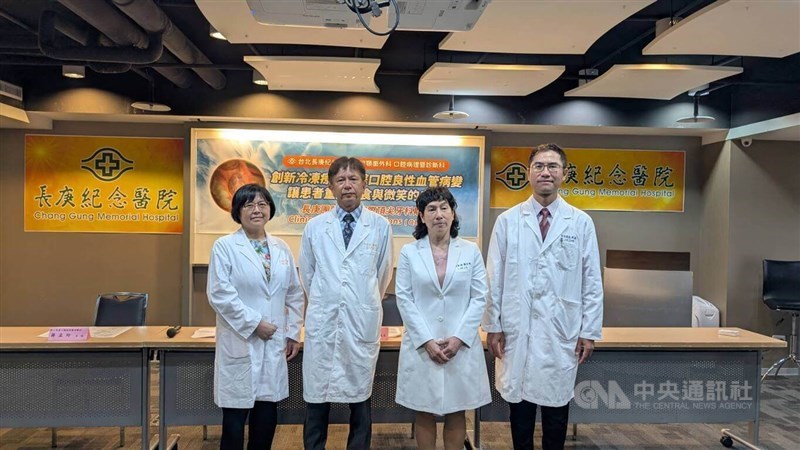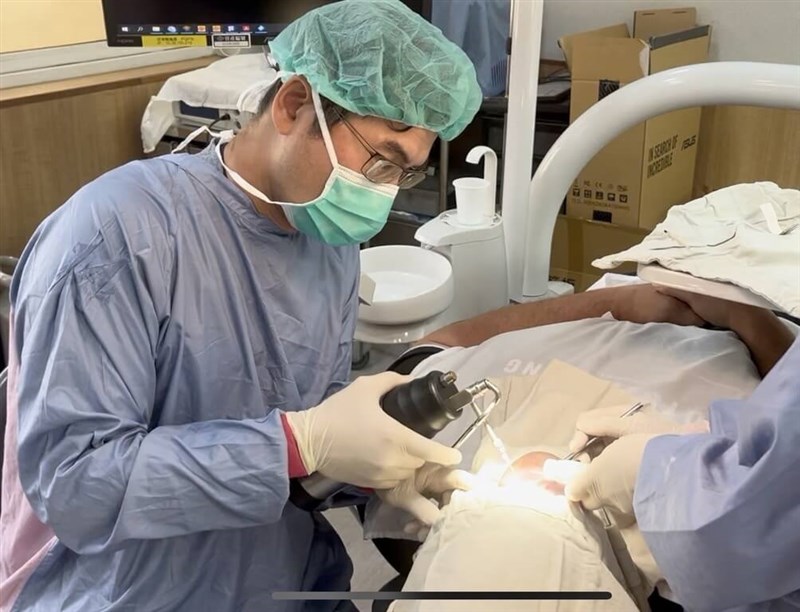Taiwan team finds cryotherapy effective against oral vascular lesions

Taipei, July 16 (CNA) Cryotherapy is effective in eliminating benign oral vascular anomalies (BOVAs) with a low risk of recurrence, offering a non-invasive alternative to traditional treatments, according to a study publicized by Chang Gung Memorial Hospital (CGMH) on Wednesday.
BOVAs are a common type of oral mucosal disease, affecting roughly six to seven out of every 100 individuals, with some developing noticeable lumps in their mouths, Jyh Kwei Chen (陳志魁), an attending physician at Taipei CGMH's Division of Oral and Maxillofacial Surgery, said at a press conference in Taipei.
The lesions on the tongue, buccal mucosa (inner lining of the cheeks), and floor of the mouth can affect appearance, interfere with eating, and may lead to bleeding or pain, he said.
In severe cases, spontaneous bleeding can result in acute complications or even become life-threatening.
While traditional treatments such as surgery and laser therapy each have their benefits -- such as immediate results or quick recoveries -- they also have drawbacks, Chen said.
"With surgery, you know it's a vascular lesion -- once you cut it, bleeding is hard to control," he said, while lasers can only treat small, shallow lesions because the light cannot penetrate deeply into bone.
In search of a safer, non-invasive alternative, Chen found scattered reports supporting cryotherapy's efficacy for oral vascular lesions, but said there were no standardized treatment protocols or long-term data on the therapy's outcomes.
From 2016 to early 2025, Chen led a team that used a cryogun -- a device commonly used in dermatology that applies liquid nitrogen at minus 196 degrees Celsius via non-contact spray -- to treat 33 BOVAs patients.
Each session lasted about 10 minutes, and most required two to three sessions.
"The principle is to destroy the structure of the blood vessels, triggering localized necrosis followed by regeneration," Chen said, and it has the advantage of being non-invasive, with no cutting or lasers involved, making it a safe treatment with minimal bleeding.
Of the 33 patients covered in the study, 32 were fully cured with no recurrence during follow-up periods ranging from five to 51 months, and only one patient did not show any significant improvement, Chen said.
The treatment also offers a faster recovery time and fewer side effects, with only minor issues reported in eight patients -- seven having localized scarring and one experiencing temporary numbness in the lower lip -- according to Chen.
"Our study further standardized the use of cryotherapy for treating BOVAs, and we hope this approach can become a standard treatment method for BOVAs in the future," he said, noting that the treatment is covered by the national health insurance (NHI) system.
The study was published in the international medical journal "Clinical Oral Investigations" in February 2025, under the title "Efficacy of cryogun cryotherapy for benign oral vascular anomalies: a longitudinal study."
In terms of early detection, Chen said BOVAs can occur in individuals of any age or gender, and people should seek a medical evaluation if they notice reddish-purple or bluish-purple lumps in their mouths, which may be signs of BOVAs.

- Culture
Vietnamese author Trang Hạ embraces life-changing lessons learned in Taiwan
12/27/2025 04:58 PM - Business
Taiwan Railway reports 1.4% rise in average daily passenger volume
12/27/2025 04:48 PM - Culture
Taipei Children's Amusement Park to ring in New Year with families
12/27/2025 04:33 PM - Society
Expert urges use of vantage points to deter crime, save manpower
12/27/2025 04:08 PM - Business
Taiwan stock market outperforms Japan, South Korea: Central bank
12/27/2025 02:51 PM